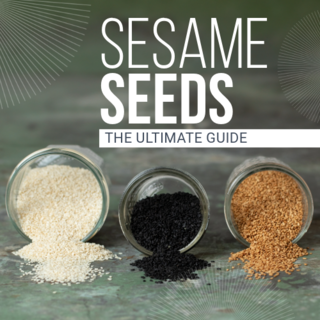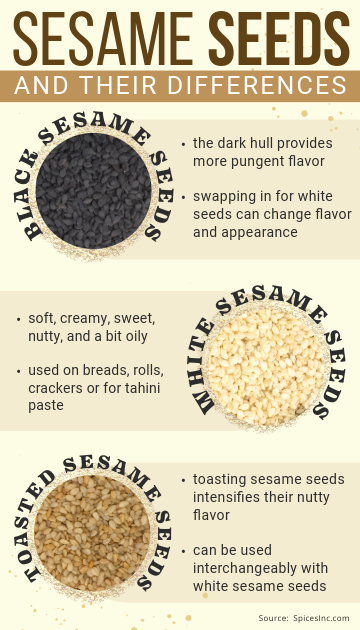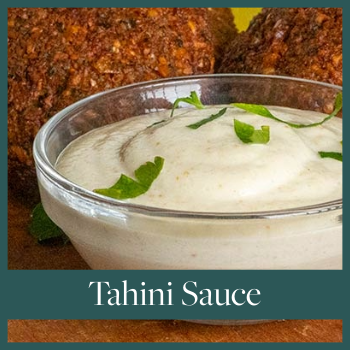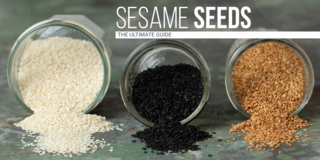The Ultimate Guide to Sesame Seeds

Sesame Seeds
Sesame seeds are one of the earliest crops known to man. They are tiny, teardrop-shaped, packed with oil, and full of sweet and nutty flavor.
Sesame seeds are fully edible and can be baked into confections, ground into a flour or into a paste, used in breads, or pressed into cooking oil. It is one of the oldest crops grown for its oil which, aside from cooking, was also used as a fuel for lamps and as a rudimentary medicine for burns.
Where Do Sesame Seeds Come From
Sesame seeds come from the inch-long pods of the sesame plant, a flowering perennial that can grow three-four feet tall. They are an ancient crop that is at homes in countries all over the world. The original sesame seed plant and other wild species of the Sesamum family in all likelihood originated in western Asia or eastern Africa.
Sesamum indicum is the species of sesame that shows the first evidence of planned cultivation, and it was actively planted and grown as long as 5,500 years ago. Evidence points to cultivation taking place on the Indian subcontinent at Harappa, in what is now Pakistan. One of the first oil crops, sesame was used throughout the ancient world, from Egypt to China, as a source of lantern and cooking oil and ground into flour.
Black Sesame Seeds
Black Sesame Seeds are the more popular sesame seed in Asian cuisines. They come from the exact same plant as white sesame seeds. Black sesame seeds have this color because they retain their dark hull. The practice of stripping a seed or fruit of its hull is relatively common; it’s what creates the difference between black and white peppercorns, or brown and white rice.
Black sesame seeds have a more pungent flavor than white seeds thanks to the presence of the hull. They are more intensely nutty and a touch bitter, and the hull delivers a chewy texture which contrasts with the creamy, oily interior. They can be used anywhere you use sesame seeds though, depending on the recipe, they may cause significant changes to the appearance of the final product.
White Sesame Seeds
White Sesame Seeds are what are most often thought of when one mentions sesame seeds. They are soft, creamy, sweet, nutty, and a bit oily. These gently flavored seeds are often found on the tops of hamburger buns and crackers. These are the mild, soft sesame seeds that are ground into smooth tahini paste, shaped into sticky benne candies, or used as a coating for fish or chicken. These seeds are most popular in the Americas, Europe, the Middle East, and the Indian subcontinent.
There are varieties of sesame seed that are pale beige even with the hulls on. This is not the variety of seed available at Spices, Inc. or that you will find in most stores.
Toasted Sesame Seeds
Toasted Sesame Seeds are, simply, hulled white sesame seeds, gently toasted until they are lightly caramelized and their nutty flavor has intensified. Since many recipes ask users to toast seeds before using, this offers convenience by eliminating a step in the cooking process. They are almost entirely interchangeable with white sesame seeds.
How To Toast Sesame Seeds
Sesame seeds can be toasted by one of two methods. They can be baked in an oven, or toasted in a skillet on the stovetop.
To bake, preheat the oven to 350°F. Spread sesame seeds out in a single layer on a rimmed baking sheet. When the oven is hot enough, put the seeds in and let them bake for about five minutes. Stir halfway through, then bake until they are uniformly golden. Check on them frequently after stirring, because these delicate seeds can go from golden to burnt very quickly.
To toast in the skillet, put sesame seeds in a frying pan, over medium heat. Leave them alone for no more than a minute, then start to stir vigorously in the pan. Keep stirring until the seeds are toasted and brown. Adjust heat as necessary if smoke rises or seeds start to toast too quickly.
When finished cooking with either method, remove seeds from the baking sheet or skillet immediately. Ambient heat will continue to toast the seeds and can cause them to burn even if they are not over direct heat. When cool, transfer to an airtight container and place in the pantry.
How To Use Sesame Seeds
Sesame seeds are often used as a coating or garnish to provide a burst of crunchy texture and nutty flavor. Scatter black sesame seeds across your favorite stir fry, fried rice, or Smoky Pork Wontons. White or toasted sesame seeds can be used to garnish curries, chicken salad, avocado toast or bowls, or in dishes like Zucchini Ravioli or Tomato Galette. White sesame seeds are often used to make candies like sesame crunch or Chili Crisp Peanut Brittle. They are also the preferred sesame seed to use when making Tahini Sauce.
Making Sesame Oil and Paste
 Sesame oil is the oil that is extracted from pressed sesame seeds. There are several ways to make sesame oil. The simplest way is to crack the seeds in a mortar and pestle and cover them in boiling water. The oil will float to the top of the water and can then be skimmed off; this method is inefficient and delivers a very low yield.
Sesame oil is the oil that is extracted from pressed sesame seeds. There are several ways to make sesame oil. The simplest way is to crack the seeds in a mortar and pestle and cover them in boiling water. The oil will float to the top of the water and can then be skimmed off; this method is inefficient and delivers a very low yield.
Sesame oil can also be extruded from seeds using a mechanical press. White or hulled seeds should be used, and they can be toasted or not, depending on the desired flavor and intensity of the oil. This delivers a higher yield from the pressing material. Presses are increasingly available in sizes that can accommodate a home chef and are not strictly industrial-level operations.
If you are in need of sesame oil and can’t get to the store or press your own, there is a third method to create oil. Grinding sesame seeds with an inert oil, like sunflower or canola oil, will allow the flavor from the seeds to extract into the oil. Seeds and oil can be blitzed together in something as simple as a countertop, bullet-type smoothie maker. Once oil and seeds are fully mixed, they can be poured into a cheesecloth and strained. Press with the back of a spatula to remove as much oil as possible from the mixture. Keep strained oil in a clean, covered container.
Sesame paste is the result of grinding seeds down until they turn into a paste. Untoasted or very lightly toasted white sesame paste is known as tahini paste, and this is found in many Middle Eastern dishes like Homemade Hummus and Baba Ghanoush. It can also be blended with oil and lemon juice to turn into Tahini Sauce.
If white sesame seeds are toasted until they are a dark golden brown and then ground to paste, that is Chinese sesame paste. It has a much more assertive, nutty flavor than tahini.
What Is A Good Substitute For Sesame Seeds
If you need a substitution for white sesame seeds, raw, hulled hemp seeds have a similar size, shape, and flavor. Flax seeds run a close second, though they are a darker brown color and have a nuttier flavor.
If you’re looking for a substitute for black sesame seeds, Nigella Sativa looks almost exactly the same. They are a similar size and color. They are also a touch bitter, and Nigella Sativa has a faintly onion-like flavor.

